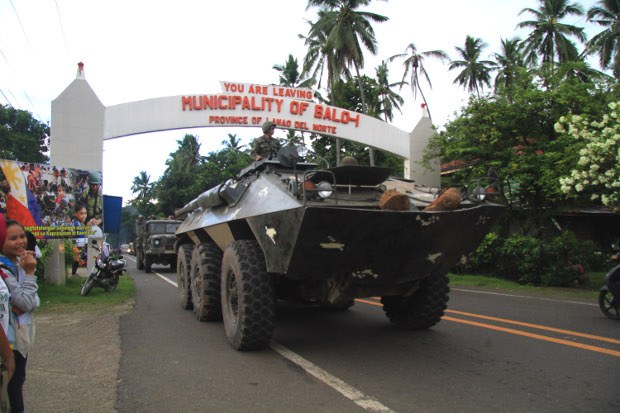Government Casualties Mount in Philippine Fight to Retake Marawi
2017.06.30
Marawi, Philippines
 A Philippine Marine convoy passes through Balo-i town in Lanao del Norte province en route to Marawi City to reinforce troops fighting to dislodge militants backed by the extremist group Islamic State, June 30, 2017.
A Philippine Marine convoy passes through Balo-i town in Lanao del Norte province en route to Marawi City to reinforce troops fighting to dislodge militants backed by the extremist group Islamic State, June 30, 2017.
Updated at 9:39 a.m. ET on 2017-07-02
Eleven more soldiers have been killed in ongoing battles between Philippine security forces and Islamic State-linked militants in the southern city of Marawi, bringing the military’s death toll to 82, according to new official figures released by the government on Friday.
Forty-four civilians have also been killed in five weeks of fighting in Marawi, Presidential spokesman Ernesto Abella told reporters in Manila in releasing updated casualty figures, which showed an increase in the number of government security personnel who had been killed.
He said the number of civilian deaths could increase because more uncollected bodies were believed to be in four villages inside Marawi, where the gunmen have been locked in gun battles with security forces.
The number of terrorists killed so far has reached 303 with no end in sight in the fighting. It began on May 23 when Abu Sayyaf and Maute gunmen, backed by foreign militants, launched attacks in Marawi, the country’s only predominantly Muslim city.
Abella said that offensive operations to retake enemy positions were ongoing, but he acknowledged that portions of four villages “remain problematic."
He said the military’s focus remains to be "the continued clearing of Marawi of remaining armed terrorists that continue to pose pockets of resistance to the advancing troops."
Abella did not provide more details on the deaths of the 11 soldiers.
It was the military’s biggest casualty figure since June 10, when officials said that 13 Marines were killed in a day of fighting with the militants.
The Marawi siege began when troops and police moved in to arrest Abu Sayyaf leader Isnilon Hapilon, the acknowledged Islamic State (IS) leader in the southern island of Mindanao.
But hundreds of gunmen composed of militants from the Maute group, backed by an undetermined number of Southeast Asian and Middle Eastern fighters, engaged the government forces in a firefight.
ICRC airs concern
Citing reports from the local crisis-management committee, the International Committee of the Red Cross said Friday that about 200 to 300 civilians were still trapped inside the conflict zone.
It was not clear if those numbers included the dozens of civilians who the gunmen had earlier seized as hostages. Officials said the hostages included a Catholic priest.
“Circumstances are dire for those trapped in Marawi as the fighting endures,” the Red Cross said in a statement. “Efforts to secure humanitarian corridors should continue to safely evacuate these civilians who have been trapped for more than a month now.”
It also expressed concern about reports that civilians were being deliberately targeted by militant snipers, and urged the gunmen to free their hostages.
Military spokesman Brig. Gen. Restituto Padilla said that more than 1,700 civilians trapped inside the battle zone had been rescued, even as more were believed to be hiding in their homes as the military carried out continuous bombing runs.
Padilla reiterated the government’s non-negotiation policy after Abdullah Maute, one of the leaders of the gunmen, had reportedly said he was willing to free the priest in exchange for his parents who had escaped from Marawi but were arrested separately by troops.
President Rodrigo Duterte has placed the entire southern region of Mindanao under martial law, giving the military extraordinary police powers that allow them to arrest anyone without a warrant.
But as security forces clawed through the city, military officials sought help from the United States. This was an embarrassing turn of events after Duterte had vowed last year to end his country’s dependence on its longtime military ally, and while he was trying to forge new defense alliances with China and Russia.
Urban setting
On Friday, Brig. Gen. Gilbert Gapay said that the “operational environment” on the ground in Marawi was different, with the enemy taking advantage of its mastery of the urban terrain.
“They were able to emplace machine guns, they were able to emplace snipers and maneuver mobility,” Gapay told reporters.
He said these factors led to the government’s high number of casualties, and he pointed out that the presence of civilians in the war zone had slowed down the advance by troops.
“But slowly but surely, with the capabilities at hand, I guess soon we will be able to clear Marawi of these terrorists,” he said, without giving a time frame.
This version clarifies how BenarNews obtained information about the increased death toll among government security personnel in Marawi.







